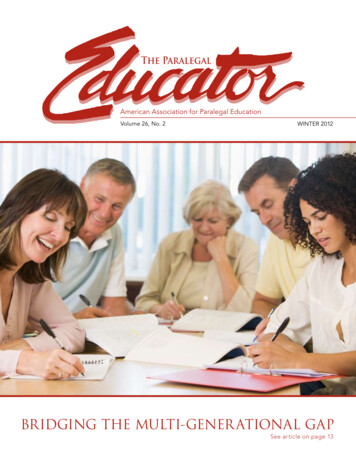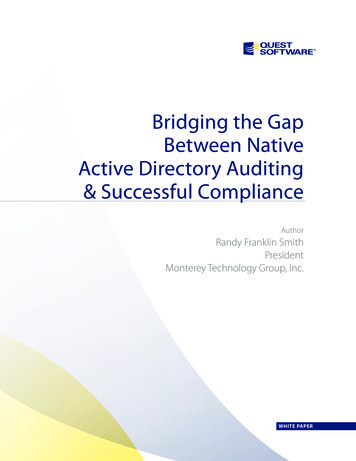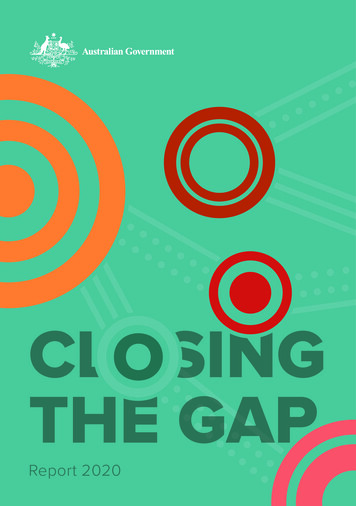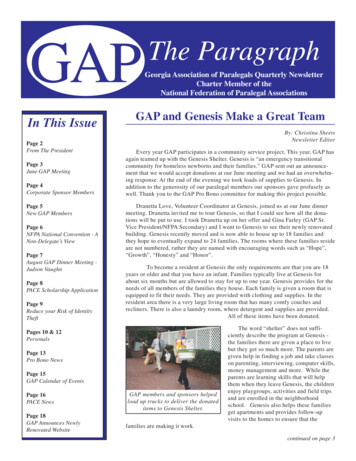
Transcription
The ParalegalAmerican Association for Paralegal EducationVolume 26, No. 2WINTER 2012BRIDGING THE MULTI-GENER ATIONAL GAPSee article on page 13
CAROLINA ACADEMIC PRESS2012Resources for ParalegalsThe Empowered ParalegalProfessionalism AnthologyN EW !Robert E. Mongue, University of Mississippi, editor2011, 370 pp, ISBN 978-1-59460-821-6, 40.00This book takes a comprehensive approach toparalegal professionalism and the paralegal professional, discussing topics such as: establishing a professional identity, regulation, certification andlicensing, paralegal associations, paralegals from theperspective of the courts, paralegal utilization.Core Grammar for LawyersRuth Ann McKinney, University of NC School of LawKatie Rose Guest Pryal, University of NC School of LawCore Grammar for Lawyers (CGL) is an online, self-directed learning tool designed to helplaw students, pre-law students, paralegal professionals, and practicing attorneys develop thegrammar and punctuation skills that are prerequisites to successful legal writing.“This important book addresses issues thateither are or should be at the forefront of every discussion of theparalegal professional today.” –– Toni Marsh, Esquire, Director,George Washington University Paralegal Studies ProgramsThis online learning tool includes all of thefollowing: a Pre-Test of grammar skills to help users identify areasof weakness; online, interactive Lessons to develop areas of present weakness; additional practice opportunities; and Post-Tests toconfirm mastery.Speak Spanish Nowfor Law OfficesFaculty can learn more about Core Grammar for Lawyers andrequest courtesy access at this link:www.cap-press.com/coregrammar/faculty.phpF ORTHCOMINGL ATE 2011!A Customized Learning Approach for Legal ProfessionalsBrian K. Jones, Cape Fear Community CollegeForthcoming Late 2011, ISBN 978-1-59460-863-6Includes supplemental audio CDThis text has been designed to promote communication in Spanishfor legal professionals, with primary focus on the functions of paralegals/legal assistants. Upon successfully mastering the phrases in thetext, readers will be able to manage situations they commonly encounter on a daily basis, give instructions and commands, ascertainpersonal information, and interact with Spanish-speaking persons ina culturally appropriate manner.Consumer Law & ProtectionNeal R. Bevans, Western Piedmont Community College2011, 262 pp, ISBN 978-1-59460-837-7, 35.00Teacher’s ManualUnfortunately, when readers look for a text to explain consumer-related issues, they are too oftenconfronted with case books that have more application to law school curricula than to a college-levelcourse. This book fills the need for a well-writtentext on consumer law and consumer protection.F ORTHCOMINGL ATEStephen Haas, National Paralegal College2011! ReadingForthcoming Late 2011, 328 pp, ISBN 978-1-59460-925-1Medical RecordsTeacher’s ManualTrust Drafting for ParalegalsAn ideal companion to a course in drafting trusts or estate planning, this book offers practical advice and sample provisions. The textdoes not delve deeply into the theory behind the applicable rules anddoes not exhaustively analyze the relevant statutes and cases. Instead,it’s designed to give the student a working understanding of the issuesmost likely to come up in real life.F ORTHCOMING L ATE S PRINGBusiness Law and2012!Organizations for ParalegalsEmily Lynch Morissette, University of San DiegoForthcoming Late Spring 2012, 400 approx. pp, ISBN: 978-1-59460-884-1,Teacher’s ManualThis text covers the knowledge students need to form business organizations, while adding a comprehensive section on intellectualproperty. (Intellectual property is one of the fastest growing segmentsof our economy.) It also covers basic investing and explanations forhow the country found itself in its current economic predicament.2 WINTER 2012 THE PARALEGAL EDUCATORN EW !A Practical Approach for Paralegals and the PublicF ORTHCOMING L ATE S PRING2012!Stanley McQuade, Campbell University School of LawForthcoming Late Spring 2012, 300 pp approx., ISBN: 978-1-61163-109-8,Teacher’s ManualThis book is designed to help legal professionals work with, andunderstand, medical records. It is the fruit of more than 20 yearsworking with lawyers, paralegals, and other compensation professionals in seminars and classrooms and is very readable and effective. Noprior knowledge of medicine or medical practice is required. TO LEARN MORE ABOUT OUR TITLES:Visit www.cap-press.com to view tables of contentsand request exam copies TO SUBMIT A PROPOSAL: Contact Beth Hallat bhall@cap-press.comCAROLINA ACADEMIC PRESS 700 KENT STDURHAM, NC 27701 (919) 489-7486
The ParalegalAmerican Association for Paralegal EducationThe Paralegal Educator is published two times a yearby the American Association for Paralegal Education,19 Mantua Road, Mt. Royal, New Jersey 08061.(856) 423-2829 Fax: (856) 423-3420E-mail: info@aafpe.orgPUBLICATION DATES: Spring and Fall/WinterSUBSCRIPTION RATES: 50 per year; each AAfPEmember receives one subscription as part of themembership benefit; additional member subscriptionsavailable at the rate of 30 per year. ADVERTISINGRATES: (856) 423-2829EDITORIAL STAFF:Janet Olejar - Editor-in-ChiefSteve Dayton - Chair, PublicationsCarolyn Bekhor - Assistant EditorGene Terry - Executive DirectorTABLE OF CONTENTSMessage from the President6Storytelling as a Teaching Technique7Bridging the Multi-Generational Gap-10113Help at Your Fingertips15President-Elect Message16Access to Justice in Canada17NFPA’s Paralegal CORE Competency Exam21Using the Web to Recruit New Students23Recruiting and Retaining “Non-Traditional” Paralegal Students26Preparing Paralegal Students for Immediate Productivity28LEX Winning Essays31The State Law Report39The Final Course: Am I ready for the “Real World?”42Changes to Library Requirements for ABA-Approved Programs46Dear Omniscient Mentor48AAfPE Bytes51PUBLISHER: American Association for Paralegal EducationArticles and letters to the editor should be submitted tothe Chair of the Publications Committee.DEADLINES: January 31 and July 31.Articles may be on any paralegal education topic but,on occasion, a Paralegal Educator issue has a centraltheme or motif, so submissions may be published in anyissue at the discretion of the Editor and the PublicationsCommittee. (A submission may be rejected as well atthe discretion of the Editor and/or Committee.)Articles may be of any length although, generally,submissions should not exceed 1,000 words.The articleshould be submitted with an appropriate title, theauthor’s biography (3-5 sentences) at the end of thearticle, and with a recent photo (.jpg at 300 dpi only).Articles should be submitted in Microsoft Word . Itis preferred that articles be double-spaced, 12-pointTimes New Roman, and follow the conventions of goodEnglish. Please spell and grammar-check articles beforesubmission. Publication and editing of submissionsare within the purview of the Editors, President, andExecutive Director. The opinions expressed in TheParalegal Educator are those of the authors and are notnecessarily those of AAfPE.Articles may be reprinted with the permission ofAAfPE. To secure permission to reprint articles,please contact the Executive Director. 2012 American Association for Paralegal EducationTHE PARALEGAL EDUCATOR WINTER 2012 3
ives)(Including access to archFor Paralegal Instructorsand Program Directorslegalmagazine esteemed by thealegralpatheisgsdinFinns asFacts &resource by other professioullpfheaasedardregdwellprofession anucators, and attorneys ased,alsegralpabyedvidneeds andwell. Articles are professions who address theproerothinsethodansas judgeinterests of paralegals.in Maryland!annual AAfPE conferencetheatothborougitinvisquartersThanks forind you to contact our headremdanuyothwigitinWe enjoyed visdents.NALA benefits for your stuto learn more about new 0 Tulsa, OK 74119 1516 South Boston, Ste. 204 WINTER 2012 THE PARALEGAL EDUCATORorg918.587.6828 www.nala.
AAfPE 2012 CalendarFebruary 15Educator articles due for spring issueFebruary 16-18Board of Directors MeetingSavannah, GAFebruary 29LEX scholarship applications dueMarch 22-23South Central Regional ConferenceNew Orleans, LAMarch 30-31North Central Regional ConferenceGrand Rapids, MIMarch 30-31Southeast Regional ConferenceMemphis, TNApril 13-14Northeast Regional ConferencePhiladelphia, PAApril 20-21Pacific Regional ConferencePark City, UTMay 31Honorary Member nominations dueJune 15-16Board of Directors MeetingSan Diego, CAJuly 1Board nominations/candidate statements dueJuly 31Educator articles due for fall issueAugust 1National Conference travel scholarship applications dueOctober 8-10Board of Directors MeetingSavannah, GAOctober 10-13Honorary Membership in AAfPEEach year, up to two persons who have providedoutstanding service to AAfPE, but are no longerinvolved in paralegal education, are conferred withhonorary lifetime membership.A nominee must have two (2) letters ofrecommendation from two (2) different AAfPEmember institutions. If you are interested innominating someone for this achievement, pleasemail and/or email your letters of recommendation,on institution letterhead by May 31st to:AAfPEc/o Scott Hauert, AAfPE President19 Mantua RoadMount Royal, NJ 08061info@aafpe.orgWriting for The Paralegal EducatorWould you like to impress your boss, your colleagues,your students? Do you have a teaching experience,knowledge relevant to the paralegal profession or asolution to a problem that you would like to share?The ParalegalAmerican AssociatiVolume 25, No.on for ParalegalEducationSPRING 20111If you are thinking “yes” to any part of these questions,then it is time to put your ideas on paper and write anarticle for AAfPE’s national peer-reviewed magazine –The Paralegal Educator.The Educator is published inspring and fall of each year. Articlescan be submitted at any time; thedeadlines for the two issues will beannounced well in advance of thesubmission date. A broad thememay be assigned to an issue tofocus on trends and concernswithin paralegal education andthe paralegal profession. Watchfor the “Call for Articles” onthe AAfPE listserve, which willprovide this information.INTERNATIONALIZING THE PARAMCURR ICULULEGAL See6 and 9.articles on pagestheIf you have any questions or would like more information,please contact Editor-in-Chief Janet Olejar atjolejar@tacomacc.edu or 253.566.505331st Annual ConferenceSavannah, GATHE PARALEGAL EDUCATOR WINTER 2012 5
Scott Hauert - AAfPE President; Phoenix CollegeMessage from the PresidentFuture-thinking Membership: ReduxAt the annual conference in Baltimore webegan a collective exploration of what qualities,characteristics, and values AAfPE’s criteria forInstitutional (voting) membership might reflectif we were to change from what it currentlyconsists of: (1) ABA-approved, or, (2) programsthat are in “substantial compliance” with theABA’s Guidelines. See AAfPE Bylaw 2.1.In prior articles and in my conversations withmany of you, I have explained the inherentchallenges with our current criteria, the mostsignificant of which is the virtual impossibilityof consistently determining what constitutes“substantial compliance” with anotherorganization’s standards. See The ParalegalEducator (Fall 2010) and Sidebar (Spring 2011).The Board heard from many of you on this importantand complicated issue. The overwhelming and mostconsistent feedback we received was that membersrecognize the need for AAfPE to have self-articulatedmembership criteria. What we also heard was that moretime, consideration, member input, and opportunity fordiscussion is also needed. Therefore, at the direction ofthose present at the business meeting, the matter wasreferred back to committee for further consideration.6 WINTER 2012 THE PARALEGAL EDUCATORIn order to provide multiple opportunities for the broadestinput, the dialogue on Institutional membership criteriawill occur over the next few months in several venues.First, the online forums will be operational the beginningof the new year. There will be a dedicated thread in theforums where we can discuss the issue. The forums willallow us to capture the valuable input of members in oneplace. Second, there will be an open forum at each of theregional conferences this spring dedicated to this issue.The open forums will provide a valuable opportunityfor face-to-face dialogue. Third, in late spring, a draftof proposed standards for Institutional membership,based on the input gathered, will be circulated to themembership for further input.At its June meeting, the Board will consider all theinput received and, if consensus can be reached, theBoard will recommend a final proposal to submit forthe memberships’ consideration at the annual businessmeeting in Savannah. In Savannah, dedicated openforums will be conducted for additional discussion on anyproposal to come before the membership at the businessmeeting. Also, more time will be allotted for the businessmeeting so that there is ample time for comment anddebate. It is my hope that with the inclusive processoutlined above, any final concerns can be addressed atopen forums in Savannah and that those concerns canbe integrated by consensus via a floor amendment at thebusiness meeting.AAfPE has several excellent position statements that themembership has previously adopted. As we contemplatepotential criteria for Institutional membership, Iencourage you to review these statements. Any newproposals should either be consistent with, or may needto explicitly supersede, the frameworks in those positionstatements. You can find all of AAfPE’s current positionstatements at www.aafpe.org under “About AAfPE.”
By LYNN LISK - University of Arkansas – Fort SmithStorytelling As A Teaching TechniqueThe material in the following article is adapted frommaterials presented by Laura Alfano, Lynn D. Lisk andSharon Ammen at AAfPE’s 2010 National Conferenceunder the title “Acting Out.”One of the most valuable teaching aids available tothose of us who teach paralegal students is storytelling.Our students have listened to and told stories for theirentire lives. Storytelling is built into the very fabric ofour society and has been used for thousands of yearsto convey information, wisdom, understanding, andvalues. Thirty-five thousand year old cave drawings existdemonstrating that from the earliest of times, storytellinghas been an integral part of humanity’s collectiveexperience. Of course, one of the absolute best thingsabout storytelling is that it is available to all teachers at alltimes free of charge. All it takes is some life experience,a little imagination, and a willingness to “act out” in frontof your students. Numerous articles exist that examineand document the value of storytelling in teaching;1 thisarticle is intended to provide practical tips and ideas toparalegal educators on how to incorporate stories intotheir classroom presentations.Storytelling reaches out to students across socio-economic,ethnic, and cultural boundaries.2 It addresses multiplelearning styles and allows students to experience coursecontent through eyes other than their own. Storiesprovide points of reference for students as they laborto understand concepts and the application of thoseconcepts in a variety of settings and situations. A goodstory will grab and keep the attention of that boredstudent in the back of the classroom and she or he willremember it when preparing an assignment or studyingfor an exam. Best of all, attorneys (who make up the bulkof paralegal educators) are trained in storytelling. Anyseasoned litigator will tell you that a primary goal at trial isto tell the jury the story of his or her client and have themidentify and agree with the client’s point of view in thematter. In fact, failing to present your case to the jury instory format is a surefire way to ensure you lose the trial.“[L]awyers who want to become effective communicatorsmust understand stories are at the heart of how peoplethink, learn, exchange ideas, and struggle to understandthe world around them.”3 Just as the juries want to hearthe story of the case they must decide, your studentswant to hear the story of the material they need to knowand use as paralegals.How then can we become better storytellers?This article seeks to answer the questionby presenting practical advice on threestorytelling issues: (1) Where do we getstories? (2) How do we organize stories?(3) How do we tell stories?First, where do we get our stories? Sources for storiesare numerous, but the absolute best source is your ownexperience. Having been through something yourselfgives you an insight and understanding of the event thatis unparalleled. I can relate to my students theinformation they need about proper service of processfrom a few court cases and the Rules of Civil Procedure.However, I can demonstrate the application of theinformation in a way they will not easily forget when Itell the story of how I used a private process server to“ambush” guests of the Oprah show.4 Telling my studentsabout my experience in a four-day federal civil rights trialwhere we obtained nominal damages and a large punitiveaward does more to explain to students how the conceptTHE PARALEGAL EDUCATOR WINTER 2012 7
of nominal damages actually works and its importancethan any textbook explanation. When it comes to gettingstories to use in your teaching, the first place to turn isyour own experience. You should consider your topic,then think back over your own personal experiences andsee if you can find one useful for explaining the topic.Additionally, when the students hear a story about whathappened to you, it “humanizes” you to the students.They know you are not just a “talking head,” but also areal person who has dealt with and experienced the verythings they are asked to understand. I tell stories aboutclient intake interviews (like the guy who was afraid theoffice was bugged by the “illuminati” who were after him);client claims and defenses (“I was cooking meth so I couldsell it and raise enough money to pay for drug rehab”);and client testimony (“I can’t lie to you jury people like Idid my lawyer, I had no business being on the road thatnight”). All these and many more of my experienceswhile practicing law illustrate concepts in class. Moreover,I know they are effective due to feedback on my facultyevaluations each semester.5The next place you should turn to when looking for astory is friends, family, and professional colleagues. Youhave developed a rapport with these people. You haveheard their stories and your knowledge of them as aperson makes it easy to get their “take” on an experiencethey have related to you. You can easily describe theirexperiences to your students and make it as interesting asone of your own stories because you know at least one ofthe people involved. I love to sit around at my state andlocal bar meetings with attorney friends of mine and listento their “war stories.” Lawyers in general love to relatethe tales of their experiences, especially the humorousones. One of my favorites is from a friend who had aclient get arrested in the courtroom while on trial for drugpossession when a bag of marijuana fell out of his pocketas he stood up when the court went into recess.Another great source for story material is news stories.I follow the news closely in order to learn about courtdecisions and other legal matters that I can turn into anexample for my class to consider. Newspapers, radio,and TV broadcasts, magazines such as Time, Newsweek,etc. are all excellent sources of stories and material youcan use to build a story. My classes have had extendeddiscussions about O.J. Simpson’s multiple cases, theMcDonald’s “hot coffee” case, the Westboro BaptistChurch case, the list goes on. Using newsworthy cases8 WINTER 2012 THE PARALEGAL EDUCATORand situations that the students are likely to have heardabout helps bring the issues to life for the students. Italso helps them understand what is actually happening inthe world around them and how the law relates to theireveryday experiences.Additional sources for stories are movies, televisionshows, and books (fiction and non-fiction). One of myfavorite assignments in my criminal law class is havingthe students watch “Bonnie and Clyde” and draft theprosecutor’s information charging Bonnie and Clydewith every crime they commit in the course of the film.Movies, T.V. shows, and books make great sources ofstories you can use to invoke discussion and examinationof issues by students even without having the studentswatch the movie/show or read the book. I have usedmore than one scenario presented in an episode of“Boston Legal,” “The Practice” or a John Grisham novel tostart a discussion or illustrate an issue. When it comes tomovies though, I cannot recommend Kent D. Kauffman’sbook, “Movie Guide for Legal Studies”6 highly enough.With a synopsis of over 90 movies involving lawyers andthe legal process and discussion and assignment ideasfor each, it is a reference work that no paralegal educatorshould be without.Finally, no listing of story sources would be completewithout mentioning the Internet. Two of my favoritesources for material on the web are www.lawhaha.com andwww.newsoftheweird.com. Lawhaha.com in particular isa great site. It was created and is continuously updated byUniversity of Memphis law professor, Andrew J. McClurg.Professor McClurg has been collecting unusual and funnystories involving the law and lawyers for many years nowand he has put together a huge listing of them–often withquotes from the actual people involved. Blogs such as“Lowering the Bar,” “Above the Bar,” and the many paralegalblogs that describe real events from the paralegal’s point ofview are also readily available and chock full of stories andexperiences you can relate to students.The next topic revolves around the organization of stories.Once you have a good story, you will want to make surethat you keep it for future use. It is far too easy to thinkof something or see something and say to yourself “thatwould be a great story to use for ” and thenforget the story when it comes time to teach .
A good idea is to jot it down in some form, even a note thatsays “Client story about cooking meth to pay for rehab” isenough if it will jog your memory sufficiently to tell the story.Once this is done, you need to decide how you will organizeyour stories, by course (Torts, Criminal Law, Bankruptcy,etc.) or by topic (Cross-examination, voir dire, clientinterviews, etc). I organize mine by topic first recognizingthat sometimes a story will fit in more than one topic or class.This way, whenever I am teaching a specific topic, no matterwhat class it is in, I can go check to see if I have any goodstories on that topic for use.Once a story is used in a particular class, I tend to keep a copyof it with the materials for that class as well as maintain it inmy topics file. While each person has their own method oforganizing materials they use for teaching purposes, I havefound this method to be the most effective in allowing almostinstant access to a story covering just about any topic I wantto discuss with my students. It also helps ensure that when Iteach the same class again in future semesters, I know exactlywhat content has been delivered in the past and needs to bedelivered again, tweaked, updated or modified. In addition,my collection of stories continues to grow and differingstories on the same topic area are collected, giving me moreoptions and flexibility when it comes time to teach the topic.I can therefore pick a story on a topic that is a better “fit” forthe class or group involved.The last topic, and the one that affects ourstudents the most, is how to tell a story.It does not matter how well a story youhave might explain a concept or illustrateits practical application, if you cannot tell thatstory in a way the students understand andrelate to. The whole point of storytelling is toget the students’ attention and have them focuson an idea or concept.When telling a story, there are two considerations thatmust be kept in mind in order to ensure the story “works.”First, you need to be clear why you are telling the story; toentertain, illustrate a very specific point, generally inform,stimulate discussion, persuade, etc. Secondly, you mustclearly identify who your audience is; identify their age,maturity level, experience level, expectations, desires,interests, understanding of the material, etc. It is only afteryou are clear on the “why” and the “who” of your storytellingthat you can focus on the actual method (or “how”) of thestory’s delivery.1. Why? You should always be very clear why you aretelling your students a story. In fact, I recommend in mostcases that you tell the students why you are going to tellthem a story before you tell it and you should certainlydo so after you have told it. By articulating why you aretelling a story, you force yourself to consider the reasonfor the story and tailor the story to fit that purpose ratherthan tell a story whose purpose is unclear. Additionally,you are telling the students what it is you want them toget out of the story and understand. If the students knowwhat they are supposed to learn from the story, they willtune in to watch for it. Further, it is easier to verify that ithad the desired effect and served the intended purposeupon completion. For example, when I tell my studentsabout my civil rights trial in which I got only nominaldamages but a large punitive award for my client, I explainto the students beforehand what the general difference isbetween compensatory, punitive, and nominal damages.I then tell them something like, “Now, let me tell youabout an actual case I worked on and let’s see if you canfigure out what type of damages I received for my clientin the case.” Then I tell the story of my client, his minorinjury (a scrape) and how the jury gave us two damageawards, one for only one dollar ( 1.00) and the other forfifty-thousand dollars ( 50,000.00).Before I tell my students the story of the case, I havealready keyed them into the concept being taught (typesof damages awarded in civil cases) and pulled them intolistening to the story so they can determine what types ofdamages are being awarded in a specific situation. Afterthe story is over, I can ask a few questions and gaugehow well the students understand the differing types ofdamages available in a civil case based on how well theycan articulate and discuss the types of damages availableand awarded in the case I told them about.2. Who?Most of us have a generally good idea aboutwho our students are: their backgrounds, age, experience,etc. In my “Introduction to Law” class each semester,I require each student to stand and introduce himself orherself to the class and tell us all a little about himselfor herself. It helps to break the ice, but more than that,it gives me information about the students in my classthat will help me gauge the manner in which I presentmaterials and tell stories over the course of the semester.Obviously, we will treat a classroom full of 18-year-old,freshly-graduated high school students very differentlythan a class of 24-year-old practicing paralegals workingon a post-graduate certificate. My night classes tendTHE PARALEGAL EDUCATOR WINTER 2012 9
to have a large number of non-traditional students whoare in their 30s and 40s coming out of a manufacturingbackground. I can say and do things with them thatwouldn’t work with my day class full of traditionalstudents simply because of the extreme differences in lifeexperiences between the two groups.A 40-year-old probably remembers enough about BillClinton and Monica Lewinsky that a discussion of thelegal and ethical issues does not have to go into as muchfactual detail about what transpired before launching intothe discussion of the actual issues. On the other hand,a group of 19-year-old students who were small childrenwhen that was the only thing that was on the nightly newswill need more information about the matter in orderto discuss the issues in the proper context. A group offormer factory workers will have an experience base thatmakes explaining sexual harassment in the work placemuch easier to do than it will be with a group of freshmenwho have little, if any, work experience. Remember as youprepare a story who the audience for your story will be.The actual how of storytelling will be significantly impactedby the who that the story is being used to benefit.Once you are clear on the “why” and the “who”, you areready to decide how to deliver your story and in fact,which story you may want to deliver or whether youeven need or want to tell a story about a particular topic.There are many ways to tell a story. I can act it out (soloor with others). I can read it, do a dramatic reading, orhave someone else read it. I can use video or audio orI can use pictures, comic strips, and the like. I do notreally like to read a story to my students unless it is veryshort, as reading long stories will put them to sleep inno time. Likewise, while having a student read a storyaloud can sometimes be effective, it needs to be a shortstory and one that is easy to read so the student doesn’tstumble around the wording or concepts involved. In myexperience a straight audio recording doesn’t really workwell most of the time for the simple reason people tendto be visual learners and they want to see what it is that isbeing discussed. There are, of course exceptions; GeorgeCarlin’s “Seven Dirty Words” routine, for example, is agood way to stimulate a discussion on First Amendmentfree speech rights and the power of government to censormedia outlets. However, I find that the use of video clips,comic strips, and acting things out are usually the bestmethods of story delivery.10 WINTER 2012 THE PARALEGAL EDUCATORWhen it comes to video clips, they a
American Association for Paralegal Education THE PARALEGAL EDUCATOR WINTER 2012 3 The Paralegal Educator is published two times a year by the American Association for Paralegal Education, 19 Mantua Road, Mt. Royal, New Jersey 08061. (856) 423-2829 Fax: (856) 423-3420 E-mail: info@aafpe.org PUBLICATION DATES: Spring and Fall/Winter










